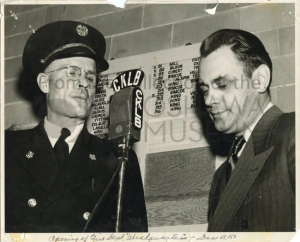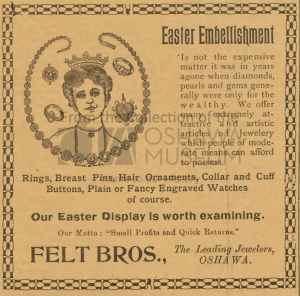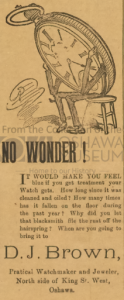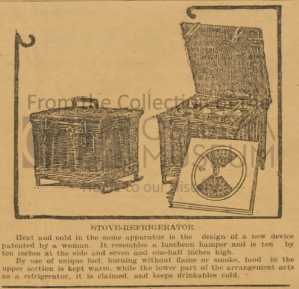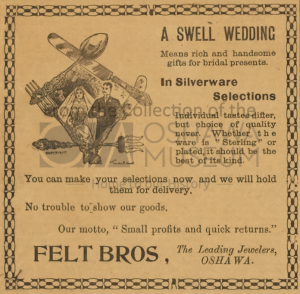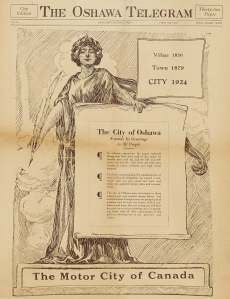The Globe and Mail, May 2, 1940, p. 14
Province Honors Hockey Champions
The Province paid tribute to Oshawa Generals, Canadian junior hockey champions yesterday following their arrival from the West. Attorney-General Gordon Conant member to the Ontario House for Oshawa district, was host to the record-establishing Oshawans, who won the Memorial Cup for two years in a row.
Conveyed in a bus from a downtown hotel, the party of sixteen players and club officials moved the Parliament Buildings, Queen’s Park, where they were met by Mr. Conant and Hon. Albert Matthews, Lieutenant Governor, and later were luncheon guests in the Ministers’ Dining-Room.
Following the dinner the Oshawa party was provided with an escort of Provincial Police for the journey home to Oshawa, where further celebrations await them.
Toronto Daily Star, May 2, 1940, p. 16
Oshawa Puck Fans Welcome Home Their Famous Junior Champions
Special to The Star
Oshawa, May 2, — With the plaudits of thousands of Oshawa fans ringing in their ears, Oshawa’s mighty Generals, monarchs of the junior hockey world from Halifax to Vancouver, returned to their home “dug-out” last night.
In spite of intermittent rain squalls, between 4,000 and 5,000 fans turned out to welcome home the Generals from western Canada, bringing with them their second memorial cup. A squad of motorcycle officers accompanied the team from Toronto in a chartered bus. Due to the rain, a huge parade and outdoor welcome had to be cancelled, so the Generals were taken to the Oshawa arena, home of some of their greatest triumphs, where they were given a civic welcome by Mayor J. C. Anderson, and members of the club and team were introduced all over again to this hockey-mad centre.
“Oshawa is justly proud of its famous Generals and much of the credit can go to the guiding hand of their president, J. B. Highfield, along with Coach Tracy Shaw,” Mayor Anderson declared.
“I know of no group of fans anywhere in Canada who are more ardent of more loyal than Oshawa fans. The boys did a grand job. They played good hockey and they obey instructions,” Coach Tracy Shaw, two-time mentor of a Dominion championship machine, said, “I hope that in the future Canada will continue to have junior clubs of the same calibre as the clubs of the two years past,” he added.
The Globe and Mail, May 10, 1940, p. 19
Three Major Trophies Won by Oshawa Generals
Dignitaries attending the championship banquet tendered Oshawa Generals, twice-crowned Dominion junior hockey champions, and the three major trophies Generals won last season are shown above. Trophies are, left to right: Richardson Memorial Cup, Eastern Canada junior championship emblem; Memorial Cup, Dominion junior championship prize, and Ross Robertson Cup, symbol of O.H.A. junior supremacy. Grouped around the trophies are, left to right: Jud McAtee, captain of the Generals; R.S. McLaughlin; J.C. Anderson, Mayor of Oshawa; George Dudley, C.A.H.A. president; Tracy Shaw, Oshawa coach, and J.B. Highfield, president of the Generals A.C.
Toronto Daily Star, May 14, 1940, p. 2
APPLES MADE MESS SO COURT UNWANTED: Utilities’ Commission Complains to Oshawa City Council
Special to The Star
Oshawa. May 14.-–Because the last time court was held in the room, a barrel of apples was dumped on a mahogany table, the magistrate’s court will no longer be allowed the use of the board room in the public utilities’ commission building.
City council was advised by George Shreve, secretary of the commission, last night.
“The whole thing started when the police court uptown was being used by Judge Coleman for division court,” said Fred Hare, city clerk. “The magistrate’s court was held down here. On that day there was a case involving apples. In order that everybody could see, part of a barrel was dumped on the desk.
“After the court was over I came in and cleaned off the table with a cloth. It was an awful mess. The case was adjourned for a few days and it so happened that the court had to come back here again on the same case and again the apples were dumped out on the table. This is the result.”
The Globe and Mail, May 14, 1940, p. 3
Strike Parley is Concluded
Oshawa, May 13 (Special) –-Conferences between General Motors company representatives and the bargaining committee of Local 222 U.A.W.A., respecting amendments to the present agreement between the union and the company, were concluded tonight.
In a statement released after the final conference, Louis Fine, Chief Conciliation Officer for the Provincial Department of Labor, said that “a proposal was worked out respecting amendments in the existing agreement which will be submitted to the Oshawa membership for gratification on Wednesday for Thursday.” …
The Globe and Mail, May 17, 1940, p. 4
Vote Dispels Strike Threat
Oshawa, May 16 (Special) –-Decisions reached at a joint conference of General Motors representatives and the bargaining committee of the Oshawa Union, U.A.W.A., were endorsed tonight by almost unanimous vote of the union membership.
Tonight’s dispelled the strike threat of last month at Oshawa. Results of similar conferences at St. Catharines and Windsor are still to be votes upon in those centres.
Union officials stated that amendments decided upon at the Oshawa conference, and approved by tonight’s vote, included clarification of the seniority system, improvement in grievance procedure, time and a half got all holidays except Good Friday, and the retention of junior help in their positions until they can be placed as adult workmen.
The Globe and Mail, May 17, 1940, p. 17
War Words Emptied by War Deeds
Oratory is the harlot of the arts. If you don’t believe James Anthony Froude read the dispatches from Ottawa:
“Tragic events have but served to intensify our determination to share in the war effort of the Allied powers to the utmost of our strength. …” The voice is the voice of the Mackenzie King Government, orating.
Now try a few facts about Canada’s utmost share to date in the war efforts of the Allied powers…
In Oshawa, Ontario, a tank battalion was called up for active service eight months ago. It is still playing at tank manoeuvres without any tanks. Each tank crew drills together on a little piece of rope. And that’s a tank for the purposes of Mr. King’s war effort. After eight months of war, In a city that lives by producing motors and motor equipment.
The Globe and Mail, May 23, 1940, p. 4
See Dissatisfaction Over Prosecution of War by Government: Volunteers Ready
Veterans of the first Great War were in the van of a movement last night to seal loopholes on the home front and at the same time compel the Government by sheer force of public sentiment to reorganize and speed up its war contribution…
At Oshawa last night 1,000 citizens met in the auditorium of Oshawa Collegiate and approved the sending of a telegram to Prime Minister King, urging immediate acceleration of the war effort and concerted action against fifth column elements.
Toronto Daily Star, May 25, 1940, p. 32
OSHAWA TO DEMOLISH ANCIENT CAR SHEDS: Mayor Says Action Will Aid Parking Problem
Oshawa. May 25. –- The former Oshawa Railway car barns and freight sheds are to be demolished. Word was received of this from the department of public works at Ottawa yesterday. Calling for tenders for demolishment of the buildings, purchased by the government as a site for a new government building, resulted from action being taken by city council.
Several weeks ago, Fire Chief W. R. Elliott condemned the building as a fire hazard.
“It will help us in solving our parking problems,” Mayor J. C. Anderson said.
With the demolishing of the old buildings, the last vestige of Oshawa’s former street car system will have vanished as workmen are now engaged in covering up the railway tracks on Simcoe St. S. Overhead wires were taken down several weeks ago.
The Globe and Mail, May 27, 1940, p. 14
MILLARD HEADS ONTARIO C.C.F.
Charles H. Millard of Oshawa secretary of the Canadian C.I.O. was elected president of the Ontario C.C.F. party at its annual convention here Saturday. He succeeds John Mitchell of Hamilton. Other officers elected are: Vice-presidents, Carroll Lawrence, Hamilton and E.B. Joliffe, Toronto…
Speaking at the evening session of the convention President-elec Millard said “the Government whose competence and shortsightdness has kept Canada in the depths of needless poverty and depression since 1928 is today proving itself equally incompetent in the face of a world disaster”
“Despite the fact that war materials are needed desperately and national debt is mounting higher and higher our industrialists refuse to turn over their factories for war production unless guaranteed a ridiculously high margin of profit. Factories he idle and the unemployed are hustled from pillar to post while the world cries for production and more production,” he said.
The Oshawa Daily Times, May 29, 1940, p 1, 8
Oshawa Camera Club Will Show Prints Tonight
More Than 150 Pictures Taken by Enthusiasts Comprise Display
Approximately 150 prints will be on display in the Hotel Genosha ballroom tonight when the first exhibition of the photography by members of the Oshawa Camera Club is opened to the public.
The Camera Club is a small group of earnest photographic amateurs who have been meeting for the past two years for the purpose of enjoying and improving their hobby by mutual assistance. Last year through the kindness of Mr. Sax Mitchell, a club room was made available over Mitchell’s Drug Store on Simcoe street north which has proved of material assistance to the welfare and advancement of the club.
The present exhibition is the first effort of its kind sponsored by the Club, although from time to time photographs by members have been on display in store windows. Numerous honors too, have been received by prints entered in competitions in Canada and England, particularly in the Toronto Camera Club which several of the local members have joined.
In addition to prints by members of the local club, there will be a number which are the work of the O.C.V.I. Camera Club. This group has been making excellent progress under the direction of Harrison Murphy, a member of the teaching staff. Another group of prints has been loaned by the Toronto Camera Club and contains many of the honor prints of the recent Spring Salon in Toronto.
There is no admission charge and the club extends a cordial invitation to the general public to visit and inspect this outstanding group of photographs. The ball room will be open this evening and also Thursday afternoon and evening. Members of the Club will be present to welcome all photographers and will be very pleased to discuss the prints, “talk shop” on the hobby and explain the aim and objects of the club.
The Oshawa Daily Times, May 29, 1940, page 1
Skilled Workers Still in Demand
Fewer Unemployed Renewing Cards Every Two Weeks
There is still an insistent demand for skilled labor all over the province, Rae Halliday, local office manager of the Employment Service of Canada, stated this morning. Weavers, lathe hands, are welders, hammer operators, mach-hands and furniture factory hands are being called for, it was learned from the cards posted in the office.
For the first five months of this year there has been an increase in orders received for help as compared to the same period last year and at the same time there has been a decrease in the number registering for work. Up to May 23 1067 orders had been received for all kinds of labor. Last year orders received up to this date were 964.
Registrations for jobs at the local office for the first five months of the year totalled 1,861 while for the same period last year the total registrations were 2235. This represents a drop of at least 374 or at the rate of 75 a month. Of the total registrations last year to May 22, 1998 names on the files renewed their cards every two weeks. This year during the same period only 1056 of the 1861 registered renewed their cards every two weeks.
This figure indicates the trend in the labor market and there is the possibility that more will be employed as Canada’s war effort increases, it was pointed out.
The Oshawa Daily Times, May 31, 1940, page 4
Air Training School Assured For Oshawa
Coupled with the government’s action to accelerate the Dominion’s war effort comes the announcement that work on 31 new airfields is to be commenced immediately and a site three miles north west of the city has been elected as one of the 31. The airfield here will be used as a preliminary air training school. Definite announcement that the Oshawa air training field was assured came from W.H. Moore, M.P., just before pres time yesterday and was in answer to a telegram sent him earlier in the day.
The establishment of an air training school here and the selection of the site surveyed, will, first of all, relieve the minds of those farmers whose lands will comprise the area. When the survey was made early in the spring the farmers were advised not to commence seeding operations and this left them in a quandary. The options on their lands will likely be taken up in a day or two.
Then the levelling of the ground, removing buildings and trees, and preparing the runways for planes will entail considerable work during the summer and fall. In addition to this work airdromes, buildings to house the staff and air force recruits will entail considerable labor and materials. It is naturally expected that local labor, as far as possible, will be engaged and local contractors will be given an opportunity to tender on the work and buildings. While details as to the complete work on the area and the buildings to be directed cannot be learned as present, the expenditure, it has been estimated, will run upwards of $300,000.
Other air training schools are being put into operation and the government is issuing a call for 5,000 more recruits to become pilots for overseas service. The activity for Oshawa this summer will centre on construction work but before another summer fledglings will be trying their wings over and around Oshawa and the hum of the engines and propellers will probably blend with other military and industrial operations, the purpose of which is to win the war and save Canada.





